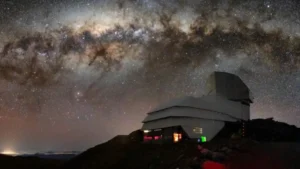The excitement around NASA’s forthcoming Venus mission inspired a team of scientists to take a fresh look at imagery from one of the original Venusian photographers: the Magellan probe.
And as is often the case when academics re-evaluate decades-old data, they made a new discovery — the first direct geological evidence of recent volcanic activity on Venus.
“I didn’t really expect to be successful,” Robert Herrick, research professor at the University of Alaska Fairbanks, told NASA. “But after about 200 hours of manually comparing the images of different Magellan orbits, I saw two images of the same region taken eight months apart exhibiting telltale geological changes caused by an eruption.”
The Magellan probe orbited Venus from 1990 to 1992. During its mission, it used its synthetic aperture radar to pierce Venus’ thick clouds and map some of the surface. Thirty years later, upon examining photos, Herrick noticed there was a new volcanic vent where once there had been nothing — the “telltale geological changes” mentioned above.

The black square shows the region of Venus where Magellan detected the volcanic activity. This map was assembled from data from the Magellan and Pioneer Venus Orbiter Missions. Photo: NASA/JPS-Caltech.
Digital challenges
But the 30-year-old images are low-resolution by current standards and were taken from two different perspectives. So Herrick initially struggled to make sense of the difference he’d spotted.
Luckily, Herrick is a member of the VERITAS team, the NASA mission that will send a brand new probe to Venus in the coming decade. Fellow team member Scott Hensley happens to be a specialist in analyzing the type of radar data the Magellan generated. Together, the two scientists used computer models to reach a joint conclusion: recent volcanic activity.

Scientists used digital tools to find the changes in Magellan’s relatively low-res images from the early 90s. Photo: NASA/JPS-Caltech
“Only a couple of the simulations matched the imagery, and the most likely scenario is that volcanic activity occurred on Venus’ surface during Magellan’s mission,” said Hensley. “While this is just one data point for an entire planet, it confirms there is modern geological activity.”
How much activity? The Venusian volcano in question, dubbed Maat Mons, generated about the amount of lava flow as the devastating 2018 Kilauea eruption. The pair published their findings in the journal Science.
VERITAS mission approaches
The VERITAS mission will soon send highly advanced sensors and instruments whizzing by the planet, generating high-resolution data that will be almost instantly available to the scientific community via the internet. Back in the ’90s, researchers had to wait on NASA to mail out boxes of CDs containing the Magellan imagery.
“Venus is an enigmatic world, and Magellan teased so many possibilities,” said Jennifer Whitten, one of the principal investigators of VERITAS. “Now that we’re very sure the planet experienced a volcanic eruption only 30 years ago, this is a small preview for the incredible discoveries VERITAS will make.”
The European Space Agency has its own Venus mission slated for the early 2030s. The two missions will carry similar sensors, both developed by the NASA-affiliated Jet Propulsion Laboratories.






